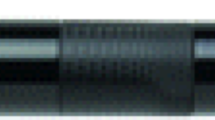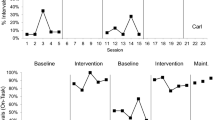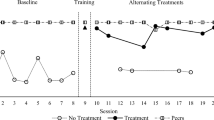Abstract
The purpose of this study was to evaluate the use of a Personal Digital Assistant with multiple prompt levels to increase completion of novel task boxes and transitioning within and between tasks. The study used a multiple probe design across three sets of task boxes replicated with three students with a diagnosis of autism spectrum disorder. Results indicated that: task completion was higher for two of the students compared to baseline conditions using a picture-based task strip; all students were able to complete a greater number of between task transitions using the PDA; students performed within task transitions equally as well using the PDA and the task strip; and one student began to self-fade use of more intrusive prompt levels.






Similar content being viewed by others
References
Attainment Company, Inc. (author) (2005–2009). Academic Work Activities and Pre-Voc One. Verona, WI: Attainment Company, Inc.
Banda, D., & Grimmett, E. (2008). Enhancing social and transition behaviors of persons with autism through activity schedules: a review. Education and Training in Developmental Disabilities, 43, 324–333.
Banda, D. R., Grimmett, E., & Hart, S. L. (2009). Helping students with autism spectrum disorders in general education classrooms manage transition issues. TEACHING Exceptional Children, 41(4), 16–21.
Billingsley, F. F., White, O. R., & Munson, R. (1980). Procedural reliability: A rational and an example. Behavioral Assessment, 2, 229–241.
Boswell, S., & Gray, D. (1999). Applying structured teaching principles to toilet training. Resources in Education, 34(10), 1–10.
Braddock, D., Rizzolo, M. C., Thompson, M., & Bell, R. (2004). Emerging technologies and cognitive disability. Journal of Special Education Technology, 19(4), 49–56.
Bryan, L. C., & Gast, D. L. (2000). Teaching on-task and on-schedule behaviors to high- functioning children with autism via picture activity schedules. Journal of Autism and Developmental Disorders, 30, 553–567.
Cannella-Malone, H., Sigafoos, J., O’Reilly, M., De La Cruz, B., Edrisinha, C., & Lancioni, G. E. (2006). Comparing video prompting to video modeling for teaching daily livings skills to six adults with developmental disabilities. Education and Training in Developmental Disabilities, 41, 344–356.
Carnahan, C. R., Hume, K., Clarke, L., & Borders, C. (2009). Using structured work systems to promote independence and engagement for students with autism spectrum disorders. TEACHING Exceptional Children, 41(4), 6–14.
Carson, K. D., Gast, D. L., & Ayres, K. M. (2008). Effects of a photo activity schedule book on independent task changes by students with intellectual disabilities in community and school job sites. European Journal of Special Needs Education, 23, 269–279.
Cihak, D. F., Kessler, K. B., & Alberto, P. A. (2007). Generalized use of a handlheld prompting system. Research in Developmental Disabilities, 28, 397–408.
Cihak, D. F., Kessler, K. B., & Alberto, P. A. (2008). Use of a handheld prompting system to transition independently through vocational tasks for students with moderate and severe intellectual disabilities. Education and Training in Developmental Disabilities, 43, 102–110.
Dauphin, M., Kinney, E. M., & Stromer, R. (2004). Using video-enhanced activity schedules and matrix training to teach sociodramatic play to a child with autism. Journal of Positive Behavior Interventions, 6(4), 238–248.
Davies, D. K., Stock, S. E., & Wehmeyer, M. L. (2002). Enhancing independent task performance for individuals with mental retardation through use of a handheld self directed visual and audio prompting system. Education and Training in Mental Retardation and Developmental Disabilities, 37, 209–218.
Davies, D. K., Stock, S. E., & Wehmeyer, M. L. (2003). A palmtop computer-based intelligent aid for individuals with intellectual disabilities to increase independent decision making. Research & Practice for Persons with Severe Disabilities, 28(4), 182–193.
Dettmer, S., Simpson, R. L., Myles, B. S., & Ganz, J. B. (2000). The use of visual supports to facilitate transitions of students with autism. Focus on Autism and Other Developmental Disabilities, 15(3), 163–169.
Dooley, P., Wilczenski, F. L., & Torem, C. (2001). Using an activity schedule to smooth school transitions. Journal of Positive Behavior Interventions, 3, 57–61.
Furniss, F., Ward, A., Lancioni, G., Rocha, N., Cunha, B., Seedhouse, P., et al. (1999). A palmtop-based job aid for workers with severe intellectual disabilities. Technology and Disability, 10, 53–67.
Gast, D. L. (Ed.). (2009). Single subject research methodology in behavioral sciences. New York: Routledge Publishers.
Graves, T. B., Collins, B. C., Schuster, J. W., & Kleinert, H. (2005). Using video prompting to teach cooking skills to secondary students with moderate disabilities. Education and Training in Developmental Disabilities, 40, 34–46.
Hume, K. (2004). I can do it myself: Using work systems to build independence in students with autism spectrum disorders. The Reporter, 10(1), 4–6.
Hume, K., & Odom, S. (2007). Effects of an individual work system on the independent functioning of students with autism. Journal of Autism and Developmental Disorders, 37, 1166–1180.
Keel, J. H., Mesibov, G. B., & Woods, A. V. (1997). TEACCH-supported employment program. Journal of Autism and Developmental Disorders, 27, 3–9.
Kimball, J. W., Kinney, E. M., Taylor, B. A., & Stromer, R. (2004). Video enhanced activity schedules for children with autism: A promising package for teaching social skills. Education and Treatment of Children, 27, 280–298.
Larkin, K. C., & Turnbull, A. (2005). National goals & research for people with intellectual & developmental disabilities. Washington, DC: American Association on Mental Retardation.
Larson, R. (2009). SHOEBOX TASKS. Asheville, NC: Centering on Children, Inc.
Lee, D. L. (2006). Facilitating transitions between and within academic tasks. Remedial and Special Education, 27(5), 312–317.
Logan, K. R., & Gast, D. L. (2001). Conducting preference assessments and reinforcer testing for individuals with profound multiple disabilities: Issues and procedures. Exceptionality, 9, 123–134.
MacDuff, G. S., Krantz, P. J., & McClannahan, L. E. (1993). Teaching children with autism to use photographic activity schedules: Maintenance and generalization of complex response chains. Journal of Applied Behavior Analysis, 26, 89–97.
Massey, N. G., & Wheeler, J. J. (2000). Acquisition and generalization of activity schedules and their effects on task engagement in a young child with autism in an inclusive pre-school classroom. Education and Training in Mental Retardation and Developmental Disabilities, 35, 326–335.
Mechling, L. C. (2007). Assistive technology as a self-management tool for prompting students with intellectual disabilities to initiate and complete daily tasks: A literature review. Education and Training in Developmental Disabilities, 42, 252–269.
Mechling, L. C., Gast, D. L., & Fields, E. A. (2008). Evaluation of a portable DVD player and system of least prompts to self-prompt cooking task completion by young adults with moderate intellectual disabilities. Journal of Special Education, 42, 179–190.
Mechling, L. C., Gast, D. L., & Seid, N. H. (2009). Using a personal digital assistant to increase independent task completion by students with autism spectrum disorder. Journal of Autism and Developmental Disabilities, doi 10.107.s10803-009-0761-0.
Mechling, L. C., Gast, D. L., & Seid, N. H. (in press). Evaluation of a personal digital assistant as a self-prompting device for increasing multi-step task completion by students with moderate intellectual disabilities. Education and Training in Developmental Disabilities.
Mechling, L. C., & Gustafson, M. (2008). Comparison of static picture and video prompting on the performance of cooking related tasks by students with autism. Journal of Special Education Technology, 23(3), 31–45.
Mechling, L. C., & Gustafson, M. (2009). Comparison of the effects of static picture and video prompting on completion of cooking related tasks by students with moderate intellectual disabilities. Exceptionality, 17(2), 103–116.
Mechling, L. C., & Stephens, E. (2009). Comparison of self-prompting of cooking skills via picture-based cookbooks and video recipes. Education and Training in Developmental Disabilities, 44, 218–237.
Mesibov, G. B., Shea, V., & Schopler, E. (2005). The TEACCH approach to autism spectrum disorders. New York, NY: Kluwer Academic/Plenum Publishers.
Norman, J. M., Collins, B. C., & Schuster, J. W. (2001). Using an instructional package including video technology to teach self help skills to elementary students with mental disabilities. Journal of Special Education Technology, 16, 5–18.
One Write Company (2006). Cyrano Communicator TM. Lancaster, OH; Author.
Ozonoff, S., & Cathcart, K. (1998). Effectiveness of a home program intervention for young children with autism. Journal of Autism and Developmental Disorders, 28, 25–32.
Panerai, S., Ferrante, L., & Caputo, V. (1997). The TEACCH strategy in mentally retarded children with autism: A multidimensional assessment. Journal of Autism and Developmental Disorders, 27, 345–347.
Panerai, S., Ferrante, L., & Zingale, M. (2002). Benefits of the treatment and education of autistic and communication handicapped children (TEACCH) programme as compared with a non-specific approach. Journal of Intellectual Disability Research, 46, 318–327.
Pierce, K. L., & Schreibman, L. (1994). Teaching daily living skills to children with autism in unsupervised settings through pictorial self-management. Journal of Applied Behavior Analysis, 27, 471–481.
Quill, K. A. (1995). Visually cued instruction for children with autism and pervasive developmental disorders. Focus on Autistic Behavior, 10, 10–20.
Rao, S., & Gagie, B. (2006). Learning through seeing and doing: Visual supports for children with autism. TEACHING Exceptional Children, 38(6), 26–33.
Rehfeldt, R. A., Kinney, E. M., Root, S., & Stromer, R. (2004). Creating activity schedules using Microsoft Powerpoint. Journal of Applied Behavior Analysis, 37, 115–128.
Riffel, L. A., Wehmeyer, M. L., Turnbull, A. P., Davies, D., Stock, S., & Fisher, S. (2005). Promoting independent performance of transition-related tasks using a palmtop PC-based self-directed visual and auditory prompting system. Journal of Special Education Technology, 20(2), 5–14.
Schopler, E., Reichler, R., DeVillis, R. F., & Daly, K. (1988). The childhood autism rating scale. Los Angeles, CA: Western Psychological Services.
Shipley-Benamou, R., Lutzker, J. R., & Taubman, M. (2002). Teaching daily living skills to children with autism through instructional video modeling. Journal of Positive Behavior Interventions, 4, 165–175.
Siaperas, P., & Beadle-Brown, J. (2006). A case study of the use of a structured teaching approach in adults with autism in a residential home in Greece. Autism, 10, 330–343.
Sigafoos, J., O’Reilly, M., Cannella, H., Upadhyaya, M., Edrisinha, C., Lancioni, G. E., et al. (2005). Computer-presented video prompting for teaching microwave oven use to three adults with developmental disabilities. Journal of Behavioral Education, 14, 189–201.
Sparrow, S. S., Balla, D. A., & Cicchetti, D. V. (1984). Vineland adaptive behavior scales. Circle Pines, MN: American Guidance Service.
Spriggs, A. D., Gast, D. L., & Ayres, K. M. (2007). Using picture activity schedule books to increase on-schedule and on-task behaviors. Education and Training in Developmental Disabilities, 42, 209–223.
Stromer, R., Kimball, J. W., Kinney, E. M., & Taylor, B. A. (2006). Activity schedules, computer technology, and teaching children with autism spectrum disorders. Focus on Autism and Other Developmental Disabilities, 21, 14–24.
Taber-Doughty, T., Patton, S. E., & Brennan, S. (2008). Simultaneous and delayed video modeling: An examination of system effectiveness and student preferences. Journal of Special Education Technology, 23(1), 1–18.
Tsang, S. K. M., Shek, D. T. L., Lam, L. L., Tang, F. L. Y., & Cheung, P. M. P. (2007). Brief report: Application of the TEACCH program on Chinese pre-school children with autism–does culture make a difference? Journal of Autism Developmental Disorder, 37, 390–396.
Van Laarhoven, T., & Van Laarhoven-Myers, T. (2006). Comparison of three video-based instructional procedures for teaching daily living skills to persons with developmental disabilities. Education and Training in Developmental Disabilities, 41, 365–381.
Van Laarhoven, T., Van Laarhoven-Myers, T., & Zurita, L. M. (2007). The effectiveness of using a Pocket PC as a video modeling and feedback device for individuals with developmental disabilities in vocational settings. Assistive Technology Outcomes and Benefits, 14(1), 28–45.
Wechsler, D. (1991). Wechsler intelligence scale for children–Third edition. San Antonio, TX: Psychological Corporation.
Acknowledgments
Special thank you to the Friends of UNCW for purchasing the task boxes used in the study and to the teaching staff and students at Noble Middle School.
Author information
Authors and Affiliations
Corresponding author
Rights and permissions
About this article
Cite this article
Mechling, L.C., Savidge, E.J. Using a Personal Digital Assistant to Increase Completion of Novel Tasks and Independent Transitioning by Students with Autism Spectrum Disorder. J Autism Dev Disord 41, 687–704 (2011). https://doi.org/10.1007/s10803-010-1088-6
Published:
Issue Date:
DOI: https://doi.org/10.1007/s10803-010-1088-6




